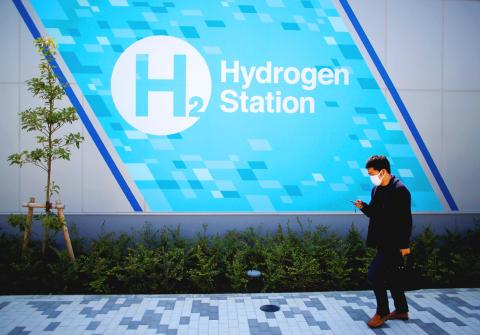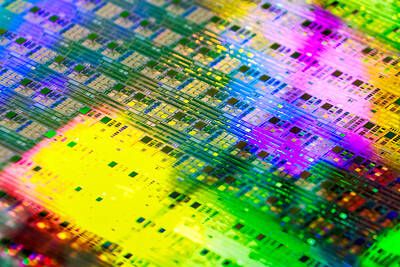Norway and Australia are racing each other to show they can supply Japan with hydrogen, hoping to fulfill its ambition to become the first nation significantly fuelled by the super-clean energy source.
While Australia has planned to derive liquid hydrogen from brown coal for some time, Norway could steal a march if a pilot project producing the fuel using “renewable” energy — a climate-friendly method more in keeping with Japan’s aims — is cheaper.
Japan is betting heavily on becoming a “hydrogen society,” despite the high costs and technical difficulties which have generally slowed its adoption as a carbon-free fuel.

Photo: Reuters
Japanese Prime Minister Shinzo Abe is pushing his vision of vehicles, houses and power stations using hydrogen to end Japan’s energy crisis since the March 2011 Fukushima Dai-ichi nuclear disaster, which led to a dramatic drop in electricity production from its nuclear plants.
The country’s annual hydrogen and fuel-cell market is forecast to hit ¥1 trillion (US$9 billion) in 2030 and ¥8 trillion in 2050, according to the Japanese Ministry of Economy, Trade and Industry.
Kawasaki Heavy Industries Ltd (KHI) is developing a supply chain to back Abe’s initiative, which is to be showcased when Tokyo hosts the 2020 Olympic Games.
KHI has been looking at using brown coal from the Australian state of Victoria, where supplies are plentiful.
However, it is hedging its bets with a project in Norway to derive hydrogen using power from hydroelectric dams and eventually wind farms.
Using Australian coal requires removing its climate-changing carbon and burying it in old oil or gas wells there.
In Norway, KHI has teamed up with Nel Hydrogen AS, a maker of hydrogen plants, with backers including Japan’s Mitsubishi Corp and Norway’s Statoil ASA. The project aims to demonstrate that liquefied hydrogen (LH2) can be produced using renewables and delivered to Japan on tankers.
Nel Hydrogen market development vice president Bjorn Simonsen told reporters that the company aims to deliver liquefied hydrogen to Japan for a minimum ¥24 per normal cubic meter. A study on the scheme is due to be completed in 2019.
KHI estimates that hydrogen from Australia costs about ¥29.8 per normal cubic meter and the company plans to establish a global LH2 supply chain like that for liquefied natural gas, KHI spokesman Keisuke Murakami said by e-mail.
“If Norway commercial [production] goes rapidly it might be earlier than Australian commercial,” he said.
Both projects still have a long way to go before they could start commercial production.
Under the Australian plan, coal would be converted to gas for processing to remove sulfur, mercury and carbon dioxide, leaving hydrogen. The Norwegian system would use renewable energy for high-temperature electrolysis to split water into hydrogen and oxygen, which would be released into the atmosphere. In both cases, the hydrogen would be liquefied for shipment to Japan.
In Australia, a small demonstration ship is being built and KHI plans to build bigger tankers in the 2020s.
The firm is also seeking support from the Victorian and federal governments, Murakami said.
A hydrogen plant would “contribute to job creation and the acquisition of foreign currencies,” he said, adding that a pilot project in Australia is scheduled to start before 2020.
Victoria is looking at the project due to the decline of brown coal mining and power stations burning the polluting fuel.
“The Victorian and Commonwealth Governments have been working with KHI on an engineering study into the possible production of hydrogen from Victorian brown coal,” Victorian Minister for Resources Wade Noonan told reporters.
The government is waiting for KHI’s results, he said.
The Japanese government is backing KHI’s Australian initiative, and budgeting ¥4.7 billion for it and related efforts this financial year, up 70 percent from the previous year. It is spending ¥22 billion backing other hydrogen initiatives.
Earlier this month, Abe called on Japanese ministers to step up efforts to “lead the world in making the hydrogen society come true.”
He called for 40,000 fuel-cell vehicles to be on the streets by the 2020 Olympics.
So far, the technology has largely been applied to cars, with hydrogen used by a fuel cell to make electricity which in turn powers the vehicle. Toyota Motor Corp launched its hydrogen-fuelled Mirai model in 2014.
However, only a few thousand Mirai — which means “future” in Japanese — are on the roads, a figure dwarfed by numbers of technically simpler battery-powered cars worldwide.
Fewer than 100 filling stations sell the fuel in Japan as safety concerns have held back development following hydrogen explosions that rocked the Fukushima Dai-ichi nuclear plant.
While Japan has high hopes of developing commercial-scale power stations using hydrogen, environmental concerns over the use of brown coal and other fossil fuels might cloud its future.
“Over 95 percent of it today comes from fossil fuels. To speak about clean hydrogen we have to clean the dirty fuel that produces it,” International Energy Agency senior renewable energy analyst Cedric Philibert said.

NO BREAKTHROUGH? More substantial ‘deliverables,’ such as tariff reductions, would likely be saved for a meeting between Trump and Xi later this year, a trade expert said China launched two probes targeting the US semiconductor sector on Saturday ahead of talks between the two nations in Spain this week on trade, national security and the ownership of social media platform TikTok. China’s Ministry of Commerce announced an anti-dumping investigation into certain analog integrated circuits (ICs) imported from the US. The investigation is to target some commodity interface ICs and gate driver ICs, which are commonly made by US companies such as Texas Instruments Inc and ON Semiconductor Corp. The ministry also announced an anti-discrimination probe into US measures against China’s chip sector. US measures such as export curbs and tariffs

The US on Friday penalized two Chinese firms that acquired US chipmaking equipment for China’s top chipmaker, Semiconductor Manufacturing International Corp (SMIC, 中芯國際), including them among 32 entities that were added to the US Department of Commerce’s restricted trade list, a US government posting showed. Twenty-three of the 32 are in China. GMC Semiconductor Technology (Wuxi) Co (吉姆西半導體科技) and Jicun Semiconductor Technology (Shanghai) Co (吉存半導體科技) were placed on the list, formally known as the Entity List, for acquiring equipment for SMIC Northern Integrated Circuit Manufacturing (Beijing) Corp (中芯北方積體電路) and Semiconductor Manufacturing International (Beijing) Corp (中芯北京), the US Federal Register posting said. The

India’s ban of online money-based games could drive addicts to unregulated apps and offshore platforms that pose new financial and social risks, fantasy-sports gaming experts say. Indian Prime Minister Narendra Modi’s government banned real-money online games late last month, citing financial losses and addiction, leading to a shutdown of many apps offering paid fantasy cricket, rummy and poker games. “Many will move to offshore platforms, because of the addictive nature — they will find alternate means to get that dopamine hit,” said Viren Hemrajani, a Mumbai-based fantasy cricket analyst. “It [also] leads to fraud and scams, because everything is now

MORTGAGE WORRIES: About 34% of respondents to a survey said they would approach multiple lenders to pay for a home, while 29.2% said they would ask family for help New housing projects in Taiwan’s six special municipalities, as well as Hsinchu city and county, are projected to total NT$710.65 billion (US$23.61 billion) in the upcoming fall sales season, a record 30 percent decrease from a year earlier, as tighter mortgage rules prompt developers to pull back, property listing platform 591.com (591新建案) said yesterday. The number of projects has also fallen to 312, a more than 20 percent decrease year-on-year, underscoring weakening sentiment and momentum amid lingering policy and financing headwinds. New Taipei City and Taoyuan bucked the downturn in project value, while Taipei, Hsinchu city and county, Taichung, Tainan and Kaohsiung